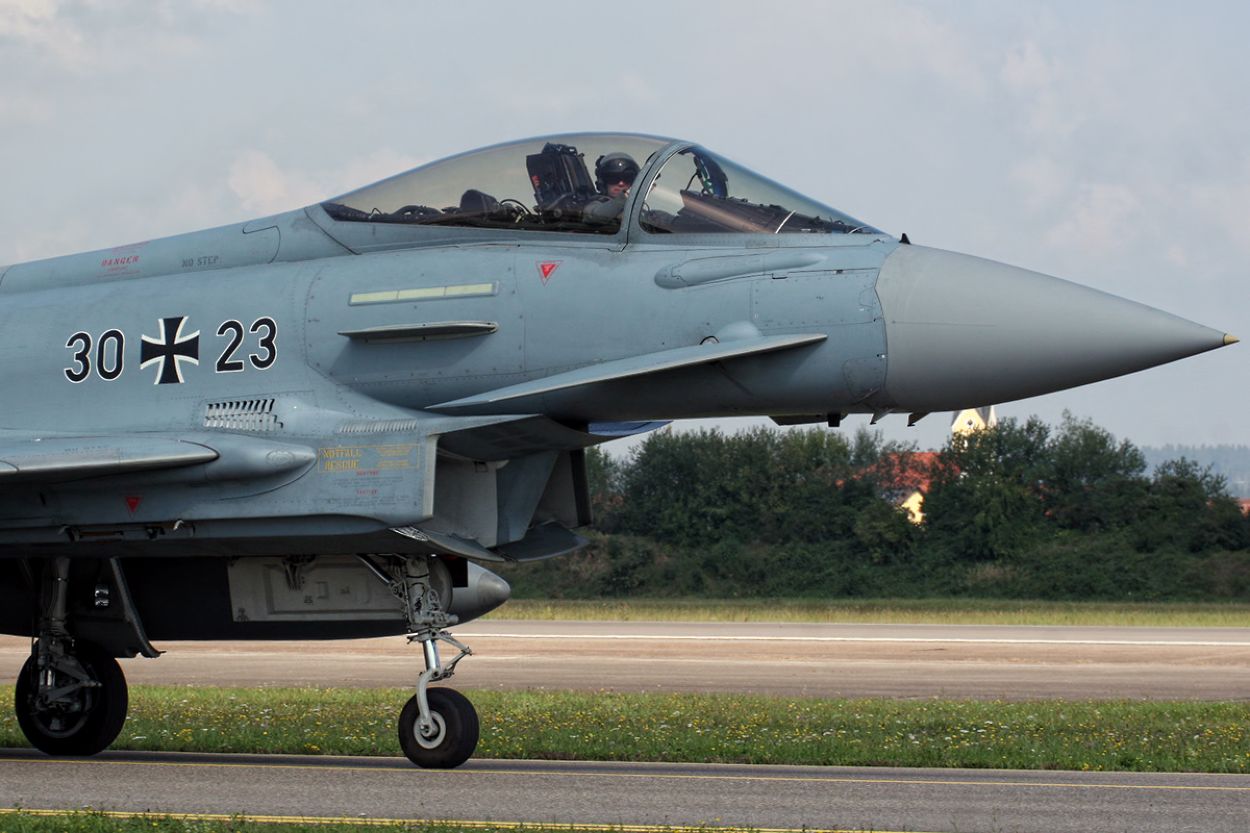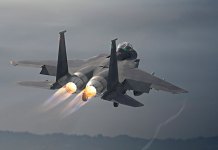A Eurofighter Typhoon fighter of the German Air Force, the Luftwaffe, suffered some damage after colliding with a drone at the Manching military airport last week. The incident, however, was unknown until now.
The German police announced on May 27 that the fighter jet pilot detected damage to the plane days after the collision on May 22. The incident reportedly happened in Bavaria, Germany, where the Eurofighter struck a drone on approach to landing at Manching Airport.
The accident occurred near Ingolstadt, where Airbus manufactures and assembles the Luftwaffe’s Eurofighter aircraft. The German police are investigating the incident. The minor collision, however, did not jeopardize the Eurofighter’s flight safety.
The extent of damage on the outer shell of the aircraft has not been made public by the authorities. The police have started an inquiry into potential violations of the Aviation Security Act and dangerous interference in air traffic since drone operations are prohibited near the airport.
Local media reports say that the police have set up a portal for uploading images and videos and requested witnesses to report details about the incident. The police stressed flying drones near airports was only permitted with requisite permissions since it could jeopardize the safety of the fighters.
If a drone gets stuck in an airplane’s engine, it may sustain serious damage. An engine problem or failure could result in a disastrous scenario, particularly during crucial flight phases like takeoff or landing.
In addition, the canopy could break or develop cracks if a drone collides with an airplane’s windshield, compromising the pilot’s view. This could lead to a dangerous situation.
This is not the first time that such an incident has been reported. Militaries worldwide now face new difficulties in domestic non-conflict zones, typically viewed as safer areas, as inexpensive commercial drones have become more widely available. The last time such a concern became a talking point was when such incidents were reported in the United States.
U.S. Also Faces Drone Menace
For the U.S. military, the rising number of unapproved drone incidents at U.S. domestic sites presents a worrying picture. A drone and an F-16 fighter jet collided in restricted airspace above the Barry M. Goldwater Range in Arizona in January 2023, underscoring the gravity of this threat. Although there were no reported injuries, the aircraft sustained damage from the crash, which required repairs.
More recently, in February 2024, the U.S. Air Force jets had to make evasive maneuvers over the Arizona desert to avoid running into drones operating in restricted airspace. No injuries were reported in this incident, but it set off alarms within the military.

These are not isolated incidents. As per reports, U.S. Air Force pilots reported several drone near-misses in the Arizona desert during 2022-2023. These incidents highlight the problem’s pervasive prevalence and the possibility of even more catastrophic mishaps.
A drone was seen flying dangerously close to the Blue Angels (formally known as the U.S. Navy Flight Demonstration Squadron, the Blue Angels are a flight demonstration squadron of the United States Navy) on August 4, 2017, during their performance over Lake Washington during the Seafair Airshow.
Another well-known incident happened in 2020 when a camera drone nearly crashed into the Blue Angels on May 12, 2020, in Detroit during their America Strong flyover.
🚨F-16 had midair collision with unidentified drone over Arizona
FAA reports reveal the scary incident is just 1 of 22 cases of military encounters with unidentified drones over restricted airspace in Arizona 2022-2023.
An @azfamily investigation reveals "a real problem" and… pic.twitter.com/BqJdEgsOBo
— Steven Greenstreet 🐷 (@MiddleOfMayhem) February 25, 2024
In 2022, the Director of National Intelligence reported the danger posed by unidentified drones sighted in sensitive or restricted airspace. The report also noted that these drone incidents heightened concerns about possible espionage activities and safety issues.
According to a previous report published in the Air Force Times, a four-star general expressed similar worries, saying that the military’s greatest worry since the advent of improvised explosive devices (IEDs) in Iraq was the proliferation of small, inexpensive drones.
Kenneth McKenzie, who helmed the CENTCOM (the United States Central Command) at the time, said the spread of small, cheap drones was the “most concerning tactical development” and emphasized that the dangers were exacerbated without a credible defense against the menace.
“I’m not just talking about large unmanned platforms, which are the size of a conventional fighter jet that we can see and deal with by normal air defense means. I’m talking about ones you can go out and buy at Costco right now for $1,000,” McKenzie said.
The U.S. military is collaborating with C-UAS (Counter-Unmanned Aircraft Systems) businesses to develop and implement technologies to identify, monitor, and deactivate unlicensed drones.
- Contact the author at sakshi.tiwari9555 (at) gmail.com
- Follow EurAsian Times on Google News




